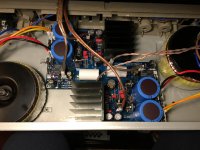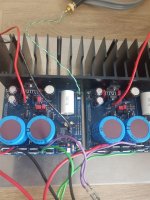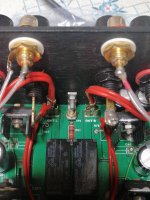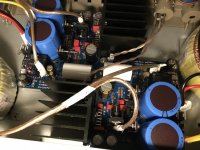Hi friends, finished assembling the pcb in std version, I really like how it feels ... I have not stopped ear since yesterday morning. guitars feel great, it doesn't tire this amp at all. I can't wait to be able to implement it with suggested components. a thank you Dario for giving us this magical project.
Attachments
So I had the opportunity to buy two sets locally, both ver1.72.
I build one set with the standard components, for the other set I ordered the better stuff from Hificollective. At the moment waiting them to arrive.
Already build the standard edition and running it since this morning as a test. One word, awesome! Builded LM3886 amps before but this one.. the best. Detailed, great soundstage.
I noticed that the LM317’s are getting pretty warm. I’m looking for the mouser part no. for this small heatsink. The heatsink that I use for R3 is to large for that position.
Any suggestion?
Thanks!
I build one set with the standard components, for the other set I ordered the better stuff from Hificollective. At the moment waiting them to arrive.
Already build the standard edition and running it since this morning as a test. One word, awesome! Builded LM3886 amps before but this one.. the best. Detailed, great soundstage.
I noticed that the LM317’s are getting pretty warm. I’m looking for the mouser part no. for this small heatsink. The heatsink that I use for R3 is to large for that position.
Any suggestion?
Thanks!
Attachments
Ciao Peppe,Hi friends, finished assembling the pcb in std version, I really like how it feels ... I have not stopped ear since yesterday morning. guitars feel great, it doesn't tire this amp at all. I can't wait to be able to implement it with suggested components. a thank you Dario for giving us this magical project.
you're welcome
From the pics I would say that you reversed the output resistor.
Already build the standard edition and running it since this morning as a test. One word, awesome! Builded LM3886 amps before but this one.. the best. Detailed, great soundstage.
Well, that was interesting!
Completed my 14th GB build (1.8 pcb's) today - delayed a little as I had to wait for some more Dale resitors to arrive from Mouser so I could finish off .... Superb boards I must say, well done and thanks to Dario for all his efforts.
Went all out for the full 'audiophile' upgrade items as Dario recommends, and built in dual mono form (thinking that would help minimise any interference, etc. between channels) - any help in a storm, and all that!
Anyway, all good, 'light bulb' tester showed I wasn't going to blow the house up or burn it down, voltages near enough spot on as expected, O/P dc around 2.7mV on first turn on.
Naturally, I was eager to get them powered up and 'soak tested', but once connected up to speakers and turned on there was a very loud 'hum' from both channels before I'd had chance to do anything at all. As mentioned, they're separate units, but both had the same level of hum.
So, start to investigate - inputs disconnected off board, still the same .... moved tranny's away from pcb's, still the same.... made sure all cables were well and truly moved away from sensitive areas, AC not running parallel to signals and so on, still the same ..... checked for any ground or other shorts (none found), still the same ....
So, I naturally dived straight into this Forum to seek out a possible cause and solution, and stumbled across OlegSh's 'problem' and resolution way back in July 2014. And, sure enough, I also found that the ONLY way I could remove this loud hum was to link PGND to PE earth, as he seemed to have needed to do as well.
That sorted it - now both channels are stone silent, and playing a brief selection of my favourite and well-known music this evening I have to say that even at this early stage of 'breaking in' it sounds terrific!
Now, I realise that under normal circumstances it should not be necessary to use this PGND connection, presuming the heatsink itself is suitably earthed - which they definitely are (measured and confirmed with digital Avo meter). Both heatsinks (actually, using side panel of HiFi2000 enclosure) are correctly earthed and I could see no other obvious errors or omissions on my part (I think!). Incoming PE is connected to enclosure base, then also linked to side panels (i.e. 'heatsink') via hard wire link.
So does anyone have any ideas what might have been going on and why I've needed to employ PGND against normal advice? Have I missed something obvious here? I'm making a presumption about a ground loop being the culprit, but where from (no input connected, remember?).
That said, I'm a happy bunny at the moment because both channels are now sounding wonderful, and I'm sure they'll continue to improve over the days and weeks to come.
Thanks again to all involved in developing and fine-tuning this great project!
Completed my 14th GB build (1.8 pcb's) today - delayed a little as I had to wait for some more Dale resitors to arrive from Mouser so I could finish off .... Superb boards I must say, well done and thanks to Dario for all his efforts.
Went all out for the full 'audiophile' upgrade items as Dario recommends, and built in dual mono form (thinking that would help minimise any interference, etc. between channels) - any help in a storm, and all that!
Anyway, all good, 'light bulb' tester showed I wasn't going to blow the house up or burn it down, voltages near enough spot on as expected, O/P dc around 2.7mV on first turn on.
Naturally, I was eager to get them powered up and 'soak tested', but once connected up to speakers and turned on there was a very loud 'hum' from both channels before I'd had chance to do anything at all. As mentioned, they're separate units, but both had the same level of hum.
So, start to investigate - inputs disconnected off board, still the same .... moved tranny's away from pcb's, still the same.... made sure all cables were well and truly moved away from sensitive areas, AC not running parallel to signals and so on, still the same ..... checked for any ground or other shorts (none found), still the same ....
So, I naturally dived straight into this Forum to seek out a possible cause and solution, and stumbled across OlegSh's 'problem' and resolution way back in July 2014. And, sure enough, I also found that the ONLY way I could remove this loud hum was to link PGND to PE earth, as he seemed to have needed to do as well.
That sorted it - now both channels are stone silent, and playing a brief selection of my favourite and well-known music this evening I have to say that even at this early stage of 'breaking in' it sounds terrific!
Now, I realise that under normal circumstances it should not be necessary to use this PGND connection, presuming the heatsink itself is suitably earthed - which they definitely are (measured and confirmed with digital Avo meter). Both heatsinks (actually, using side panel of HiFi2000 enclosure) are correctly earthed and I could see no other obvious errors or omissions on my part (I think!). Incoming PE is connected to enclosure base, then also linked to side panels (i.e. 'heatsink') via hard wire link.
So does anyone have any ideas what might have been going on and why I've needed to employ PGND against normal advice? Have I missed something obvious here? I'm making a presumption about a ground loop being the culprit, but where from (no input connected, remember?).
That said, I'm a happy bunny at the moment because both channels are now sounding wonderful, and I'm sure they'll continue to improve over the days and weeks to come.
Thanks again to all involved in developing and fine-tuning this great project!
Last edited:
Naturally, I was eager to get them powered up and 'soak tested', but once connected up to speakers and turned on there was a very loud 'hum' from both channels before I'd had chance to do anything at all. (...)
So, start to investigate - inputs disconnected off board, still the same .... moved tranny's away from pcb's, still the same.... made sure all cables were well and truly moved away from sensitive areas, AC not running parallel to signals and so on, still the same ..... checked for any ground or other shorts (none found), still the same ....
(...)
So does anyone have any ideas what might have been going on and why I've needed to employ PGND against normal advice? Have I missed something obvious here? I'm making a presumption about a ground loop being the culprit, but where from (no input connected, remember?).
Hi Richard,
that loud hum was present with input disconnected (as it seems)?
If so it's perfectly normal since it's a floating design, it's the input signal ground that 'grounds' the entire amp...
It was so with input connected?
Maybe you inverted signal hot with signal ground
It's a band-aid, check input connection first.And, sure enough, I also found that the ONLY way I could remove this loud hum was to link PGND to PE earth, as he seemed to have needed to do as well.
That sorted it - now both channels are stone silent, and playing a brief selection of my favourite and well-known music this evening I have to say that even at this early stage of 'breaking in' it sounds terrific!
You' re welcome, I'm happy you're enjoying itThat said, I'm a happy bunny at the moment because both channels are now sounding wonderful, and I'm sure they'll continue to improve over the days and weeks to come.
Thanks again to all involved in developing and fine-tuning this great project!
Well, that was interesting!
... PE connection, presuming the heatsink itself is suitably earthed - which they definitely are (measured and confirmed with digital Avo meter). Both heatsinks (actually, using side panel of HiFi2000 enclosure) are correctly earthed and I could see no other obvious errors or omissions on my part (I think!). Incoming PE is connected to enclosure base, then also linked to side panels (i.e. 'heatsink') via hard wire link.
Thanks again to all involved in developing and fine-tuning this great project!
Hmm.. Do I understand well, that Before the PGND was not connected anywhere, neither the HS points..?
So that the heat sinks + case were connected Only to the PE of the power line input?
If that is the case, I'm afraid that You have misunderstood the situation: naturally the amplifier PGND 'must' be connected to the case & heatsinks!!
Than it will be connected also to the PE, for safety reasons. But exactly because of that hum, noise pickup, the case must be directly, low inductance way connected to the amp PGND point.. Always!
Last edited:
Dario,
Thanks for the advice - I'm sure I/P connection polarity is correct, but I'll check again to make sure. And yes, very loud hum is present, and at same level, whether I/P is connected or disconnected, no difference.
Joseph,
Thanks for your confirmation - I followed the build guide which clearly states "The My_Ref and so the My_Ref Fremen Edition are floating designs so they’re not supposed to be grounded."
I took this as being a literal advice, and so yes I did not connect PGND or HSGND to anything, so looks like my bad and my misunderstanding in that case!
Circuit diagram shows both of these points connect through to GND, so I (wrongly it seems) presumed this GND would be picked up somewhere else in circuit; but now thinking about it, it must be fed from somewhere of course - which I guess is indeed the PGND connection!!! Doh!
Thanks both - all now working OK in the end, which is the main thing.
Thanks for the advice - I'm sure I/P connection polarity is correct, but I'll check again to make sure. And yes, very loud hum is present, and at same level, whether I/P is connected or disconnected, no difference.
Joseph,
Thanks for your confirmation - I followed the build guide which clearly states "The My_Ref and so the My_Ref Fremen Edition are floating designs so they’re not supposed to be grounded."
I took this as being a literal advice, and so yes I did not connect PGND or HSGND to anything, so looks like my bad and my misunderstanding in that case!
Circuit diagram shows both of these points connect through to GND, so I (wrongly it seems) presumed this GND would be picked up somewhere else in circuit; but now thinking about it, it must be fed from somewhere of course - which I guess is indeed the PGND connection!!! Doh!
Thanks both - all now working OK in the end, which is the main thing.
Richard,
Let me demonstrate, how it had been resolved by Penasa, in his original design, the MyEvolution:
On the pic, that L is directly connected to the PGND part of the ground plain. ( I'm connecting to PE in a different part of the chassis, but they could be united)
Let me demonstrate, how it had been resolved by Penasa, in his original design, the MyEvolution:
On the pic, that L is directly connected to the PGND part of the ground plain. ( I'm connecting to PE in a different part of the chassis, but they could be united)
Attachments
George,Let me demonstrate, how it had been resolved by Penasa, in his original design, the MyEvolution:
On the pic, that L is directly connected to the PGND part of the ground plain. ( I'm connecting to PE in a different part of the chassis, but they could be united)
these last grounding recommendations are a bit confusing...
the PGND arrangement in your pic is the one of the original My_Evo, but in Rev A Mauro replaced R81 with a wire jumper (so that PGND is tied directly to the chassis) and disconnected PE from the chassis (see page 4 of the My_Evo Rev A guide).
Also Richard interpreted correctly the build guide, usually the PGND should be connected to PE via a ground breaker or, taking a small risk, left unconnected (the best sounding solution).
Can you elaborate?
Thanks in advance
Attachments
Dario, "certo che si.."
You are right, but You know more than necessary..
I did not want to complicate the message with historical details.
The case is that also in that amp of mine (Evo) the 'rev A' mod is executed, that resistor is jumpered (from below) and PGND ground plain is effectively directly connected to the chassis.
What You are telling, that second part is also true: connecting to the PE was discussed different times before.
My point of view now is connect to it. Safety reasons, law.
Goes against good signal integrity, but what can you do..
You are right, but You know more than necessary..
I did not want to complicate the message with historical details.
The case is that also in that amp of mine (Evo) the 'rev A' mod is executed, that resistor is jumpered (from below) and PGND ground plain is effectively directly connected to the chassis.
What You are telling, that second part is also true: connecting to the PE was discussed different times before.
My point of view now is connect to it. Safety reasons, law.
Goes against good signal integrity, but what can you do..
Last edited:
Try to explain further: the chassis must be at a good schield potential, if it is floating, it behaves on the contrary of a schield, it's a bloody big antenna directly communicating with the several MHz bandwith power chips.. A well schielded case around this circuit to me, for me always had brought only positive results.
For me this amp in a case without good quality schield connection.. Is a ticking clock..
The PE, on the other hand, brings only heavy dirt and disturbs to the circuit. With the PE directly on chassis one gets assured that the dirt has a highway connection into the circuit..
But/ and not connecting the circuit PGND to the chassis - do not give any better protection, and permits this kind of strong noise interference what Richard had experienced..
For me it's a lose /lose situation, unfortunately..
Ciao, George
For me this amp in a case without good quality schield connection.. Is a ticking clock..
The PE, on the other hand, brings only heavy dirt and disturbs to the circuit. With the PE directly on chassis one gets assured that the dirt has a highway connection into the circuit..
But/ and not connecting the circuit PGND to the chassis - do not give any better protection, and permits this kind of strong noise interference what Richard had experienced..
For me it's a lose /lose situation, unfortunately..
Ciao, George
Ciao Peppe,
you're welcome
From the pics I would say that you reversed the output resistor.
Thanks Dario for the suggestion of R3, I have reversed it, but what do you say who knows if he will have suffered damage playing for a week? now, however, the sound has remained very beautiful, warm and transparent. I'm enjoying listening to all my favorite records, it feels like listening to a nipva version. a pleasant surprise. I'm happy. thank you
Attachments
- Home
- Amplifiers
- Chip Amps
- My_Ref Fremen Edition - Build thread and tutorial



